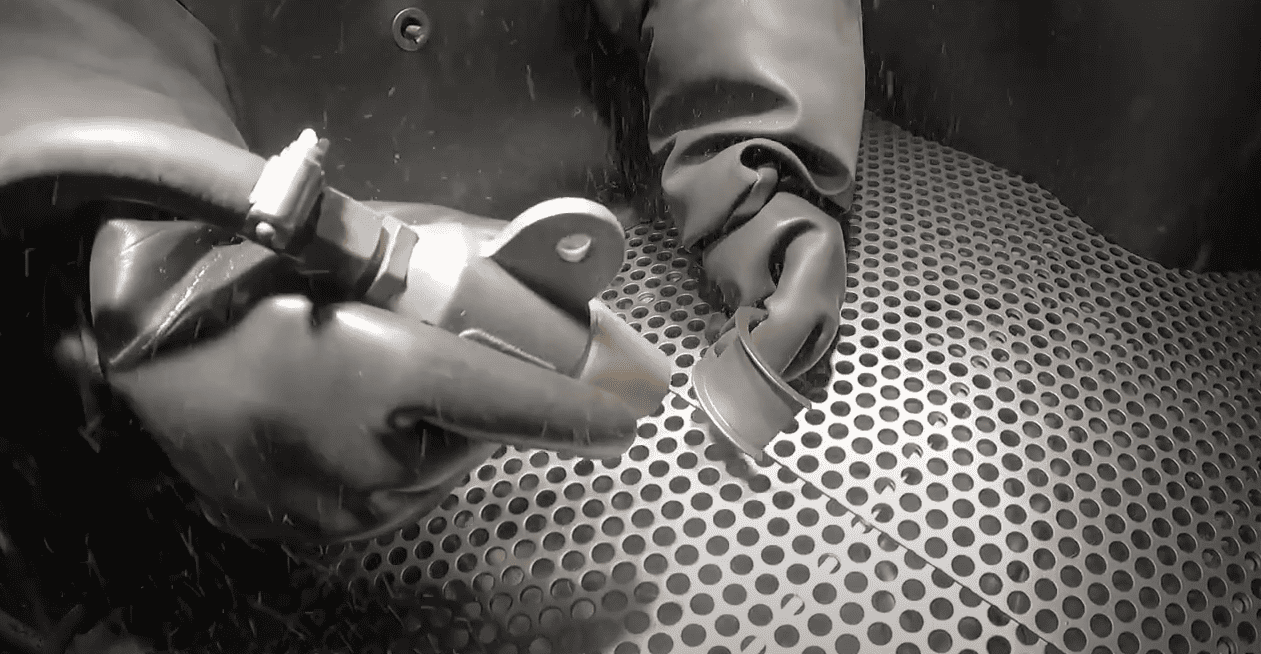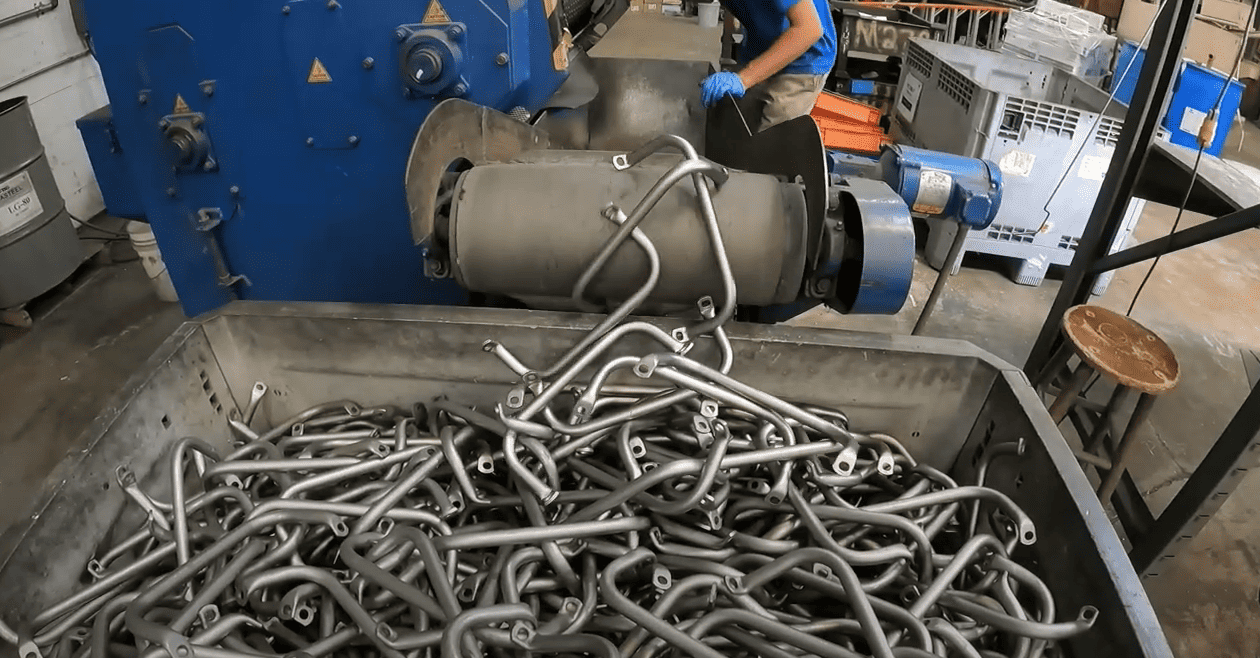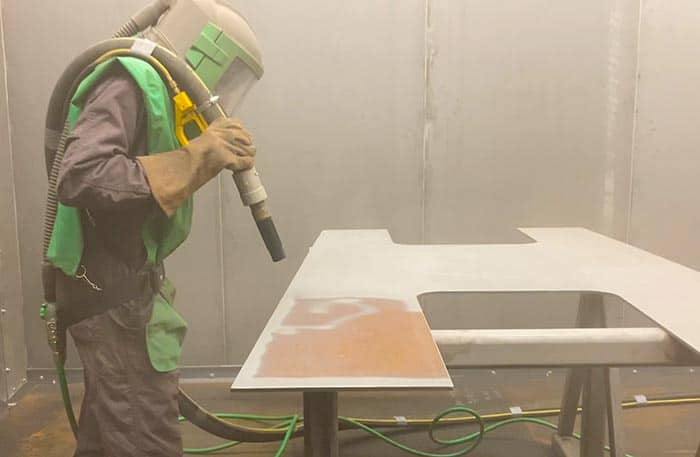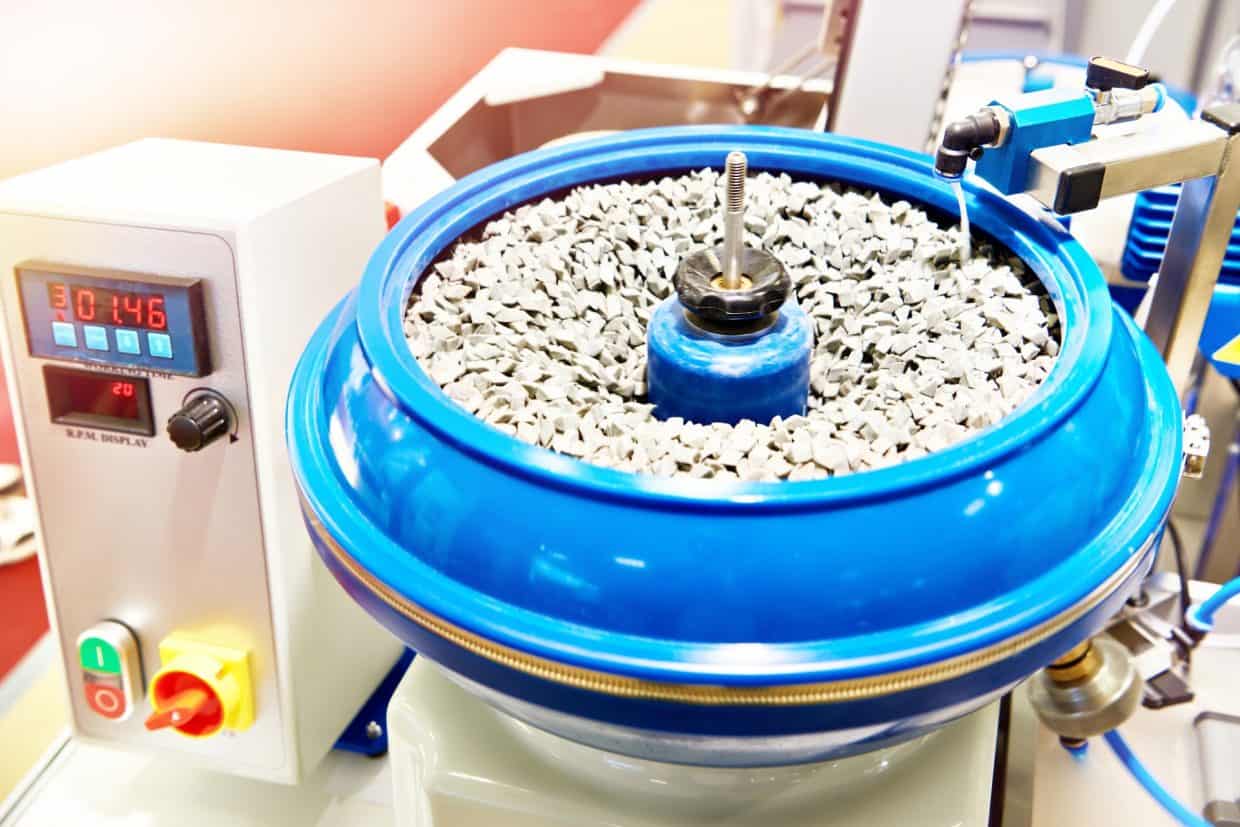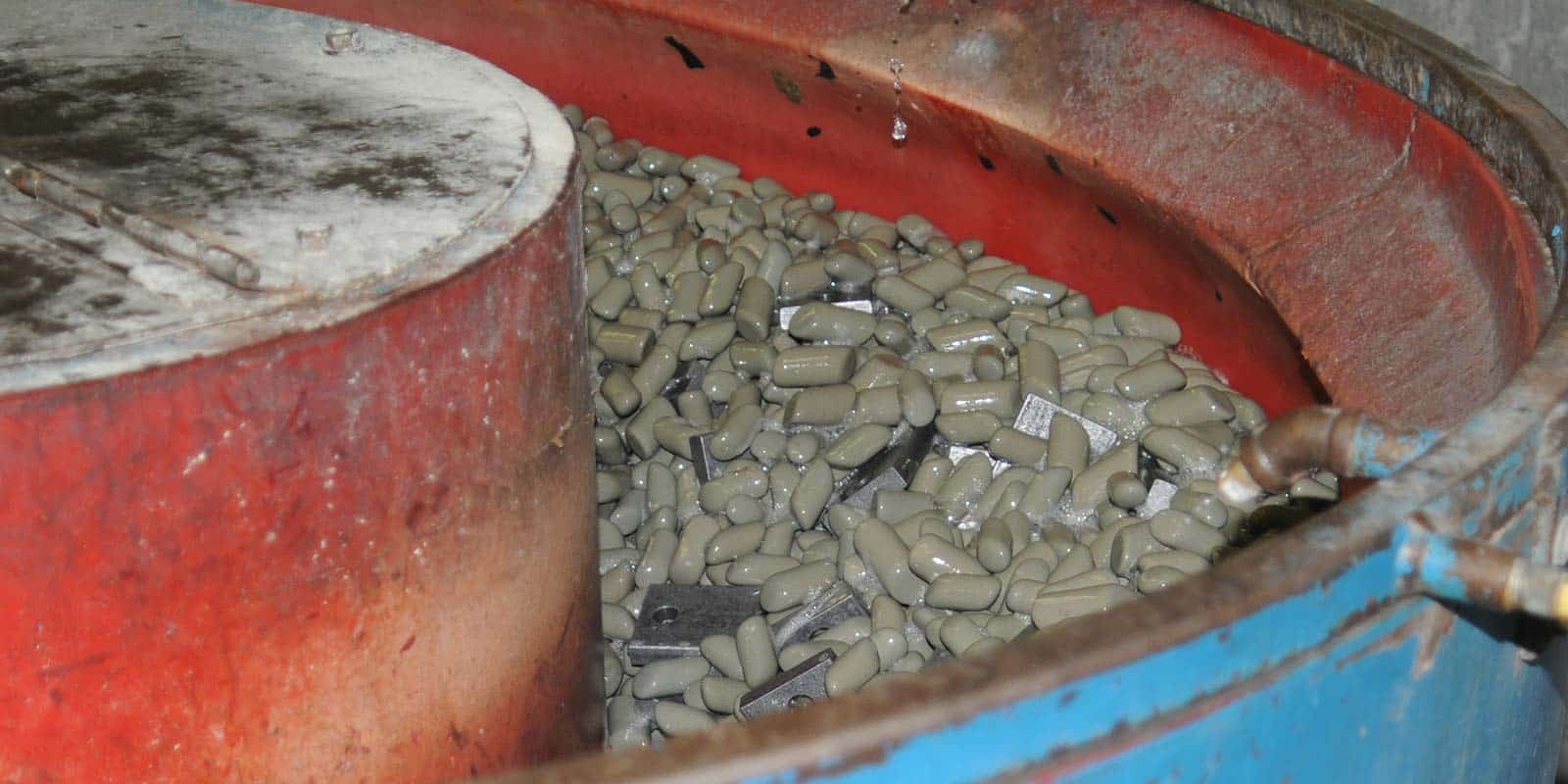Pros and Cons of Suction and Pressure Sandblasting Systems
Suction vs Pressure Sandblasting Systems | When choosing an abrasive blast cabinet, there are two main types to consider: suction and pressure. The decision of which type to go with will depend on a number of factors, including the process requirements, abrasive used, production numbers, available compressed air, and the parts being blasted.
But before we get into the details of each style, let’s take a quick look at what separates the Empire Abrasive Blast Cabinet from other available options on the market today.
Empire Pro Finish Cabinet
Empire ProFinish cabinet is a high-performance cabinet built with execution and versatility in mind. It sets the standard for industrial applications and features a tunable reclaim system and dust collector, which not only helps you save on media consumption, but it also removes dust, oversize particles, and fines from your working mix. This results in increased consistency and productivity. The Empire dust collectors can capture 99% of all particles one micron or larger, and they are offered in bag house or cartridge collectors. The Empire ProFinish cabinet is also backed by a three-year limited warranty; one of the best in the industry.
Let us take a closer look:
Empire Reclaimer:
-
- Saves on media consumption: The Reclaimer helps to recover and clean used media, which can save you money on the cost of new media.
- Removes dust, oversize particles, and fines: The Reclaimer removes dust, oversize particles, and fines from the working mix. This helps to improve the consistency of the mix and the quality of the finished product.
- Increases productivity: The Reclaimer helps to reduce the amount of time spent cleaning and reloading the blast cabinet. This can lead to increased productivity.
Empire dust collectors:
-
- Capture 99% of all particles one micron or larger: The dust collectors are highly effective at capturing dust and other particulate matter. This helps to protect the health and safety of workers and to prevent environmental pollution.
-
- Offered in bag house or cartridge collectors: The dust collectors are available in two different types: bag house collectors and cartridge collectors.
NOW, LET’S GET INTO THE DETAILS….
Pressure Blast Cabinets:
During active blasting, a plunger seals the opening to the vessel, preventing abrasive from falling from the hopper into the pressure pot. The pressurized pot forces abrasive out of the blast pot and through the blast nozzle. This direct pressure makes the Empire Pressure system great for heavy duty coating and corrosion removal, as well as profiling a surface. These cabinets are also built for speed and heavy duty cleaning.
One way to identify a pressure system is by examining the nozzle and hose. If you see a nozzle connected to a single hose, you are looking at a pressure system (suction systems use an air hose and media hose connected to a gun).
One downside of the Empire Pressure system is that you are limited to the capacity of your pressure pot for continuous blasting. This means that when the pot runs out of abrasive, you must stop blasting and allow the media to recirculate back into your pot through your reclaimer.
|
PROS |
| 4-5 times faster cleaning speed than suction cabinet: Empire Pressure system uses compressed air to blast abrasives at the surface to be cleaned. In turn, this makes the system much faster than the suction cabinet method of using a vacuum to pull abrasives across the surface. |
| Great for heavy duty coating and corrosion removal: The Empire Pressure system can be used to remove even the most stubborn coatings and corrosion, making it ideal for industrial applications. |
| Built for speed and heavy duty cleaning: The Empire Pressure system is made from high-quality materials and is designed to withstand the rigors of heavy-duty cleaning. |
|
CONS |
| Higher initial and operating costs: The pressure cabinet price is significantly higher than a suction system. The additional maintenance required and replacing of wear parts will also increase the operating costs. With that said, you can recover this investment quickly from the increased productivity. |
| Limited capacity for continuous blasting: When the pot in the pressure cabinet runs out of abrasive, the blasting process must be stopped to allow recovered media to be returned to the pressure vessel. For this to happen, the operator must remove his foot from the pedal until all recovered media is returned to the pot. This can be inconvenient if you are in the middle of a cleaning job. |
| Faster breakdown of abrasive: With higher speed and increased production, media will wear at a faster rate compared to a suction unit. That is why a harder more recyclable media will be more cost effective in a pressure blast cabinet. |
Suction vs Pressure Sandblasting System
A FEW OTHER THINGS TO CONSIDER:
Cost of a pressure system
The price tag for a pressure cabinet is also going to be larger than a suction cabinet. This is because pressure systems require more expensive components, such as a pressure pot and the abrasive metering valve. Additionally, if you need to upgrade your air compressor to accommodate the higher air demands of a pressure system, this will add to the overall cost.
Cost of operating and maintaining a pressure system
In addition to the price tag, you will also need to factor in the additional costs of energy, maintenance, and wear parts to operate and maintain a pressure system. Pressure systems use more energy than suction systems, so you can expect to see an increase in your energy bill. Additionally, pressure systems require more frequent maintenance and replacement of wear parts, such as the blast nozzle and hoses.
SUCTION BLAST CABINETS:
Suction blast cabinets use compressed air to create a vacuum that pulls the abrasive out of the gun. This type of cabinet is identified by the presence of a blast gun with two hoses: one for air and one for media.
Suction blast cabinets are not as powerful as pressure blast cabinets, but they do have several advantages. They are less expensive, require less energy and air, and need less maintenance and replacement of wear parts. They also allow for continuous blasting without having to stop and wait for the media to replenish every time it cycles. This ability to blast continuously is why suctions guns are so productive in automated blasting processes.
Another key advantage of the suction blast cabinet is the ease of emptying and replacing your abrasive, especially if you plan to use multiple medias and/or grit sizes. It typically takes less than 10 minutes to remove media from a suction hopper and add a new one, but changing out or switching the abrasive in a pressure system is time consuming and can get pretty messy.
In addition, suction blast cabinets expel the media at a lower velocity, which means that the abrasive lasts longer. This can save you money on abrasives in the long run.
However, suction blast cabinets do have some limitations. They are not as effective as pressure blast cabinets for cleaning heavy coatings or corrosion, and they are not ideal for use with heavier medias like metallic abrasive.
Overall, suction blast cabinets are a good option for light cleaning and delicate parts, but they are not as powerful as pressure blast cabinets and can’t be used for all applications.
Empire Suction System:
Summarizing the pros and cons of the Empire Suction system
|
PROS |
CONS |
| Lower cost: Suction blast cabinets are less expensive than pressure blast cabinets. This is because they do not require as much upkeep or power | Not as powerful as pressure blast cabinets: Suction blast cabinets are not as powerful as pressure blast cabinets. This means that they are not as effective for cleaning heavy coatings or corrosion. |
| Less energy and air usage: Suction blast cabinets use less energy and air than pressure blast cabinets. This can save you money on your utility bills. | Cannot use heavier abrasives: Suction blast cabinets cannot use heavier abrasives like metallic abrasive. |
| Less maintenance: Suction blast cabinets require less maintenance than pressure blast cabinets. This is because the components are not subjected to as much wear and tear. | |
| Continuous blasting: Suction blast cabinets allow for continuous blasting without stopping to replenish the media in the pressure pot. This can save you time and productivity and is ideal for automated processes | |
| Longer abrasive life: Suction blast cabinets expel the media at a lower velocity, which means that the abrasive lasts longer. This can save you money on abrasives in the long run. |
Suction Blast Cabinets: Some additional tips
Use the correct abrasive for the job. Not all abrasives are created equal. Use an abrasive that is specifically designed for the type of cleaning or surface preparation you need to do.
Use the correct air pressure. Too much air pressure can damage the cabinet or the parts you are cleaning. Too little air pressure will not be effective.
Suction and Pressure Cabinets A quick summary: pros and cons
Suction Cabinets
Pros:
- Lower initial cost
- Less compressed air required
- Easier to maintain and swap abrasive
Cons:
- Slower cleaning speed
- Not as effective for heavy-duty cleaning
- Cannot use heavier abrasives
Pressure Cabinets
Pros:
- Faster cleaning speed
- More effective for heavy-duty cleaning
- Can use heavier abrasives
Cons:
- Higher initial cost
- Requires more compressed air / Energy
- Requires increased maintenance / PM’s
Pressure vs Suction Sandblasting System: CONCLUSION
Ultimately, the best way to choose the right blast cabinet for your needs is to consider the following factors:
- Your specific needs and requirements: What type of work will you be doing with the blast cabinet? What size parts will you be blasting?
- Available compressed air: How much compressed air do you have available? Pressure blast cabinets require more compressed air than suction blast cabinets.
- Your budget: How much money are you willing to spend on a blast cabinet? Pressure blast cabinets are more expensive than suction blast cabinets.
- Your specific application requirements: What type of abrasive will you be using? What level of cleaning do you need?
Once you have considered the above factors, you can start to narrow down your choices. If you need a cabinet that can handle heavy-duty cleaning and use of heavier abrasives, then a pressure system may be a good choice for you. However, if you just want something that is easy to maintain, is cost-effective, or if you have an automated process, then a suction system is an easy choice.
At the end of the day, the decision of whether to choose a pressure system or a suction system is a personal one. You need to weigh the pros and cons of each type of system and decide which one best fits in with your needs.

